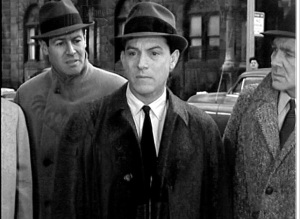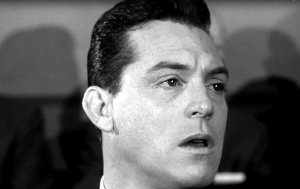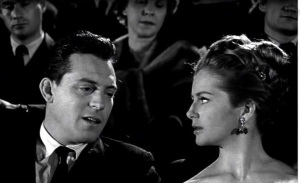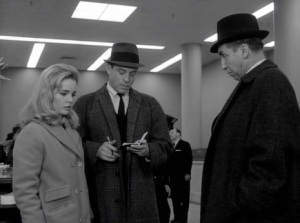 In an Italian restaurant near the New York City Criminal Court Building, Detective Adam Flint is brooding about the nature of guilt.
In an Italian restaurant near the New York City Criminal Court Building, Detective Adam Flint is brooding about the nature of guilt.
“I deal with guilt every day, and it’s been years I thought about what it really is,” he muses to his actress fiancée Libby.
At this moment, Detective Flint has good reason to wonder. He’s in the restaurant during the lunch recess of a murder trial—the re-trial, actually, of a thief and murderer named Joseph Creeley. Detective Flint apprehended Creeley years earlier, in a violent confrontation that followed Creeley’s robbery of a jewelry store. In the course of the robbery, Creeley killed the old man who owned the store and permanently crippled his widow.
Flint is a prosecution witness in this trial, as he was in the previous one that sent Creeley to death row. But this time, Flint is hoping that the defense will prevail.
You see, shortly before Creeley’s scheduled execution, doctors found a tumor growing in the criminal’s brain. When they removed it, they also removed the past 10 years from Creeley’s memory, as well as the violent impulses that took over his life in the months leading up to the robbery.
Creeley’s defense attorney is arguing that the tumor caused that violent behavior—that the tumor, in fact, was the real murderer.
This kind of complicated moral dilemma is a defining feature of Naked City, which began life as a half-hour series based closely on the 1948 Mark Hellinger film of the same name. John McIntire recreated Barry Fitzgerald’s role as the wise and experience Lieutenant Muldoon and dimply James Franciscus played rookie detective Jimmy Halloran.
Like the motion picture Naked City, the series filmed in New York City, largely on the city’s streets.
Critics embraced it from the beginning.
UPI’s William Ewald praised the show’s layered treatment of crime and justice: “It recognizes that not all juvenile delinquents are punks, that violence is a symptom of something out of joint, that life isn’t merely a matter of the good guys versus the bad guys. And although its plots are usually thin, sorrow and pity wash over its flesh. It faces up to the human condition, unlike slicker action shows…”
The show died after one season. Producer Herbert Leonard and frequent writer Stirling Silliphant went on to create another acclaimed series, Route 66, then got the green light to revive Naked City in an hour-long format.
Debuting in 1960, this version starred Paul Burke as sensitive young Detective Adam Flint opposite Horace McMahon’s crusty Lieutenant Mike Parker. (Harry Bellaver played another 65th precinct officer, Detective Frank Arcaro, throughout both versions of the series.)
This version aired for three seasons, and its 1963 cancellation surprised its cast and outraged critics.
In a way, though, it seems fitting that Naked City died when it did, before the assassination of John F. Kennedy ended the brief era of idealism it represents, and before the rapid cultural shifts of the late 1960s polarized our national discourse in ways that still reverberate today.
Naked City’s vision of the human experience is as complex as the city in which its stories unfold, as varied as those 8 million people who populate it.
Since this is the Classic TV Detectives Blogathon, I prepared by focusing on the detectives themselves. This isn’t easy because Naked City does not dwell on its officers’ backstories and personal motivations. In Season One, we get occasional glimpses of Detective Halloran’s wife; she mostly waits at home and worries about him. Subsequent seasons give a more substantial role to Detective Flint’s fiancée Libby, who’s living a proto-That Girl life as an aspiring actress. Nancy Malone imbues Libby with warmth and intelligence, and she and Paul Burke make Libby and Adam a believable couple. Libby still mostly exists to be a sounding board and solace for Adam, though.
As I watched episodes whose events touched the show’s detectives in a more personal way than usual, I learned little about their lives but a lot about the moral vision that guides them—and, by extension, the show itself:
1. “Everything is gray.”
Those are the words that Joseph Creeley mutters as he awakens after surgery and finds a 10-year void in his memory. Struggling with the nature of guilt, Adam repeats these words during his lunch with Libby. His ability to see so many sides to an issue frustrates him, although Libby assures him it’s one of his finest qualities.
This is one of Naked City’s finest qualities, too. Its stories evoke a measure of our sympathy for nearly every character, even those we first encounter during brutal acts of violence.
Consider this 10-minute opening sequence from 1961’s “Requiem for a Sunday Afternoon.” We feel the wronged husband’s pain but can’t see the young man dragged into this situation (Burt Reynolds!) as a villain. We can even find some understanding for the wife, trapped in a marriage she never wanted.
2. When you want to know who you are, look inward.
In “Bullets Cost Too Much,” Adam endures the shifting winds of public opinion. Paying a visit to a bar that hasn’t been closing on time, he witnesses an armed robbery. A mouthy drunk gets in the thieves’ way and gets shot, while Adam sits and watches, unable to intervene without endangering other bar patrons. The thieves get away, although Adam shoots one during the escape.

The jeering crowds that gather around Adam even toss out the ultimate Cold War-era insult, likening him to Communist security forces.
In a parallel story, the doctor brother of one of the thieves struggles with his conscience as he treats the wounded man and avoids alerting the authorities.
In the end, Adam helps capture the thieves and earns headlines as glowing as previous ones were critical.

Libby frames both to remind Adam to rely on his own sense of integrity, rather than external assessments.
(In the show’s typically complex way, we are left to doubt whether Adam’s original judgment in the bar was correct. The doctor’s girlfriend, a sympathetic and unbiased character, tells Libby that she studied bar diagrams closely and believes that Adam could have used the element of surprise to save the drunk’s life.)
3. “Life is precious, every hour of it.”
Those are Adam’s words in the Joseph Creeley trial, as he explains why he authorized Creeley’s risky brain surgery. (Unable to decide for himself about the surgery, Creeley had given Adam his power of attorney.)
Adam’s reverence for life faces its toughest test in “Prime of Life” when Lieutenant Parker orders him to witness an execution.

As moments pass slowly in the death chamber, Adam has flashbacks to the condemned man’s crime, as well as to his own agonized soul-searching in the weeks leading up to the execution.
After the execution, as Adam drives away from the prison, we are left to reflect on the words Lieutenant Parker used when tasking Adam with this duty: “That gun you carry gives you the power of life and death…maybe it’s a good thing to think about life and death.”
4. “We are all responsible for each other.”
Describing a 1958 episode about juvenile delinquency, TV critic Fred Remington described the main character’s problem as “a terrible, aching loneliness.”
Naked City rarely attaches labels or diagnoses to its criminals, but a lack of human connection seems to drive many of them.
In the first-season episode “ And a Merry Christmas to the Force on Patrol,” an officer subbing for Detective Halloran on Christmas Eve gets shot during a liquor store stake-out. One thief, Marco, is captured, but he refuses to help police identify or locate his brother. Halloran is shaken and angry, but Lieutenant Muldoon takes a softer approach. When Marco learns that his brother was shot while fleeing, Marco breaks down and tells Muldoon where to find him.
Later, Muldoon has to return to Marco’s cell to inform him that his brother died before police got to him.
(By the way, Frank Sutton plays Marco. If, like me, you know him mainly as Sergeant Carter in Gomer Pyle, his dramatic acting in this and other Naked City episodes will amaze you.)
“We are all responsible for each other,” is what Adam tells Libby after the Joseph Creeley case goes to the jury. She doubts whether she could handle the responsibility of deciding a man’s fate, but Adam argues that judging and being judged is part of our human compact.
5. There are no easy answers—and sometimes no answers at all.
Naked City doesn’t paint criminals as monsters, but it does not downplay crime’s horror. When violence erupts on this show, it is usually sudden and brutal.
The 1962 episode “A Case Study of Two Savages” has a particularly high body count. Arkansas’ Ansel Boake (Rip Torn) arrives in New York with his teenage bride and begins shooting everyone who gets in his way. This includes Detective Frank Arcaro, who merely stops to tell the youth that his license plate is loose.
A convalescing Arcaro tells Adam to find out why the young man shot him. When police finally catch up with Ansel and kill him during a bank robbery, his wife (Tuesday Weld) can’t offer much of an answer.
Likewise, Jimmy Halloran comes up short during the first-season episode “Burst of Passion,” which concerns the kind of mass shooting we see all too often today. Jimmy’s friendly, church-going neighbor snaps, embarking on a shooting rampage. Witnesses debate the killer’s mental state, while Jimmy tracks the man down to the deserted off-season environs of Coney Island. (I love the scenery in this one.)
Halloran ends up shooting his neighbor; before dying, the man rambles semi-coherently about mankind’s failures and the need to begin again.
We’re left with narrator’s observation that sometimes there are no answers, at least not comforting ones.
We get no answers in the Joseph Creeley case, either.

After the jury gets the case, Adam and Libby leave it and the New York Criminal Court Building behind. Due to his faith in the jury system, Adam conveys a renewed sense of peace.
My first reaction on watching this episode was annoyance that we didn’t learn the jury’s decision. Then I realized that this story’s thorny moral dilemma doesn’t lend itself to a simple answer—it is something viewers need to think through for themselves.
In the world of Naked City, asking questions is more important than finding answers.
Read more entries from the Classic TV Detectives Blogathon.






















